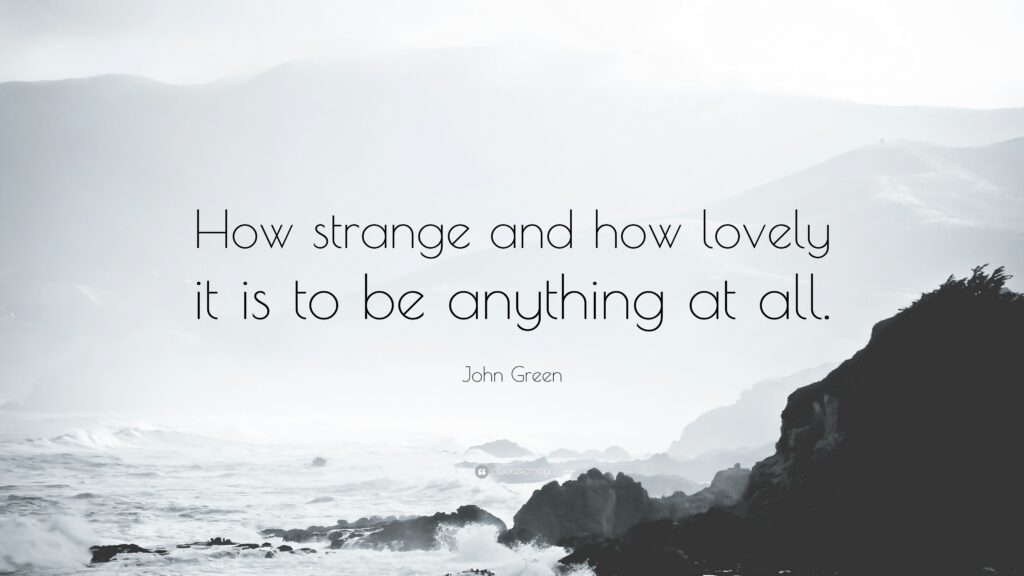How Strange It Is to Be Anything at All
The realization of one’s own existence is a profound and often overwhelming experience. The sheer fact that we are conscious beings, aware of ourselves and the world around us, is a mystery that has puzzled philosophers and thinkers throughout history. The phrase “How strange it is to be anything at all” eloquently captures this sense of wonder and bewilderment at the mere fact of being.This sentiment has been expressed in various forms by many different people, from philosophers to artists and musicians.
In his 2004 song “In the Aeroplane Over the Sea,” Jeff Mangum of the band Neutral Milk Hotel sings, “How strange it is to be anything at all.” This line has resonated with many listeners, who find in it a reflection of their own existential musings.The idea that it is strange to exist at all has been explored by philosophers throughout history. In his seminal work “Being and Time,” Martin Heidegger grapples with the question of what it means to be, and how we can understand our own existence in relation to the world around us. Heidegger argues that we are always already thrown into a world that we did not choose, and that our existence is characterized by a constant struggle to make sense of our situation.Other philosophers, such as Jean-Paul Sartre, have also explored the theme of existential bewilderment. In his novel “Nausea,” Sartre’s protagonist, Antoine Roquentin, is struck by the sheer facticity of existence, the brute reality of being. Roquentin experiences a profound sense of unease and disorientation in the face of the world’s indifference to his existence.
The feeling of strangeness in the face of one’s own existence is not limited to philosophy, however. It has also been a recurring theme in art and literature. In his painting “The Persistence of Memory,” Salvador Dalí depicts a surreal landscape in which melting clocks seem to suggest the illusory nature of time and the fragility of existence. The painting’s haunting imagery evokes a sense of the uncanny, the strange and unsettling feeling that something is not quite right.Similarly, in his novel “The Unbearable Lightness of Being,” Milan Kundera explores the idea of existence as a kind of lightness, a weightlessness that can be both liberating and terrifying. Kundera’s characters grapple with the question of how to live authentically in a world that seems to offer no clear answers or meaning.
The feeling of strangeness in the face of one’s own existence is not limited to the realm of high culture, however. It has also found expression in popular music and literature. In his song “Dust in the Wind,” the American rock band Kansas sings, “All we are is dust in the wind.” This line captures the sense of the insignificance and transience of human existence in the face of the vastness of the universe.Similarly, in his novel “The Hitchhiker’s Guide to the Galaxy,” Douglas Adams presents a universe that is both absurd and indifferent to the concerns of human beings. The book’s protagonist, Arthur Dent, is thrust into a series of bizarre and bewildering situations that force him to confront the strangeness of his own existence.Despite the prevalence of this feeling of existential bewilderment, it is important to note that it is not a universal human experience. Many people are able to find meaning and purpose in their lives without being overwhelmed by the strangeness of existence. Religious and spiritual beliefs, for example, can provide a framework for understanding one’s place in the world and the significance of one’s existence.
Moreover, the feeling of strangeness in the face of one’s own existence is not necessarily a negative or debilitating experience. For some, it can be a source of inspiration and creativity. Artists and writers have often drawn upon this sense of existential unease to produce works that challenge our assumptions about the nature of reality and the meaning of life.In conclusion, the phrase “How strange it is to be anything at all” captures a profound and often unsettling aspect of the human experience. It reflects the sense of wonder and bewilderment that we can feel in the face of our own existence, and the questions that this raises about the nature of reality and the significance of our lives. While this feeling is not universal, it has been a recurring theme in philosophy, art, and literature, and continues to challenge and inspire us to think deeply about the nature of our own being.
FAQs
What does it mean to be anything at all?
To be anything at all means to simply exist, to be conscious and aware of one’s own existence. It reflects the profound mystery and strangeness of the mere fact of being, of being a conscious being in a world that exists independently of us.
Why is it strange to be anything at all?
It is strange to be anything at all because the mere fact of existence is so difficult to comprehend. We are conscious beings in a world that seems to operate according to its own laws and indifferent to our concerns. The sheer facticity of existence, the brute reality of being, can be deeply unsettling and bewildering.
How do philosophers view the strangeness of existence?
Philosophers have grappled with the question of existence and the strangeness of being throughout history. Martin Heidegger argued that we are always already thrown into a world that we did not choose, and that our existence is characterized by a constant struggle to make sense of our situation. Jean-Paul Sartre explored the idea of existential bewilderment in his novel “Nausea,” in which his protagonist experiences a profound sense of unease and disorientation in the face of the world’s indifference to his existence.
How do artists and writers explore the strangeness of existence?
Artists and writers have often drawn upon the sense of existential unease to produce works that challenge our assumptions about the nature of reality and the meaning of life. Salvador Dalí’s painting “The Persistence of Memory” evokes a sense of the uncanny, the strange and unsettling feeling that something is not quite right. Milan Kundera’s novel “The Unbearable Lightness of Being” explores the idea of existence as a kind of lightness, a weightlessness that can be both liberating and terrifying.
Can the strangeness of existence be a source of inspiration?
For some, the feeling of strangeness in the face of one’s own existence can be a source of inspiration and creativity. Artists and writers have often drawn upon this sense of existential unease to produce works that challenge our assumptions about the nature of reality and the meaning of life. The strangeness of existence can be a catalyst for deeper reflection and exploration of the human condition.
| Reason | Link |
|---|---|
| Martin Heidegger’s exploration of the question of existence in “Being and Time“ | https://en.wikipedia.org/wiki/Being_and_Time |
Read more about it:https://greyhoundsverdevalley.com/what-best-describes-the-association-between-the-carbon-cycle-plants-and-animals/



